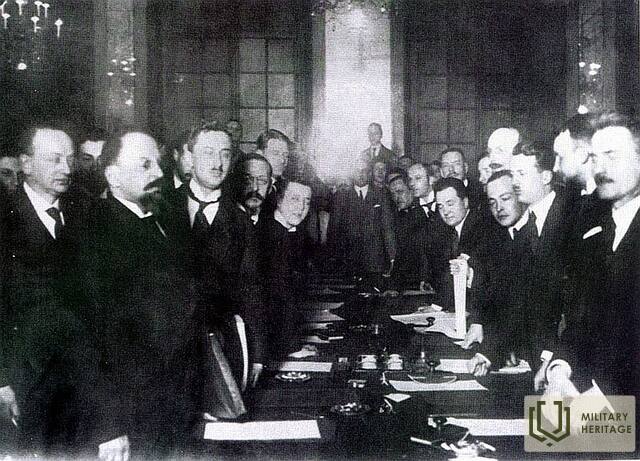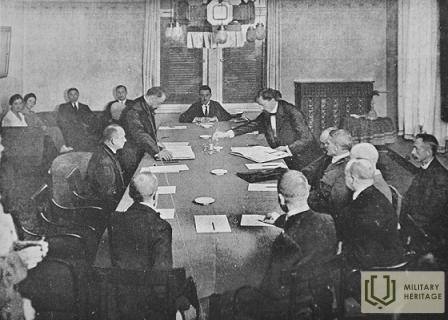Latvijos ir Sovietų Sąjungos taikos sutartis
I WW1, I Nepriklausomybės karai

1920 m. sausio 30 d., išlaisvinus Latgalą iš Raudonosios armijos, Latvija ir Sovietų Rusija sudarė slaptas paliaubas. Latvijos pusė reikalavo laikyti susitarimą slaptu, kad nekiltų nereikalingų komplikacijų su savo sąjungininke Lenkija, kuri 1920 m. rimtai kariavo su Rusija. Taikos derybų nebuvo galima laikyti slaptomis ir jos prasidėjo Maskvoje 1920 m. balandžio 16 d. Lygiai prieš metus vokiečiai Liepojoje surengė perversmą, sumažindami Latvijos vyriausybės jurisdikciją iki vieno laivo („Saratovas“) denio ir kelių parapijų Šiaurės Vidžemėje. Po metų Latvija buvo išlaisvinta ir jos vyriausybė galėjo derėtis su galingos Sovietų Rusijos vadovybe kaip nugalėtoja. Rusija taip pat buvo suinteresuota kuo greičiau sudaryti taiką, kad galėtų sutelkti visas savo pajėgas prieš Lenkiją ir prieš generolo Vrangelio vadovaujamą anticarinę armiją Kryme. Atrodo, kad didžiausi taikos derybų priešininkai buvo į Rusiją pabėgę Latvijos bolševikai, kurie svajojo apie galimybę atkovoti Latviją, tačiau tarp dviejų šalių sudaryta taika šiai svajonei padarys galą.
Latvijos delegacijai taikos derybose su Rusija vadovavo socialdemokratas Jānis Vesmanis. Delegacijoje taip pat buvo Pēteris Berģis, Ansis Buševics, Eduardas Kalniņš ir Kārlis Pauļuks. Taikos derybos vyko šešiose komisijose: karinėje, politinėje, teisinėje, nuolaidų, finansinėje ir reevakuacijos. 1920 m. liepos mėn. derybos iš Maskvos persikėlė į Rygą. Po ilgų ir sudėtingų derybų 1920 m. rugpjūčio 11 d. abi pusės pasirašė taikos sutartį. Sovietų Rusijos pusėje taikos sutartį pasirašė Ā. Jofe ir J. Gaņeckis.
Taikos sutartį sudarė 23 straipsniai. Antroje sutarties pastraipoje Rusija pripažino Latvijos nepriklausomybę ir „savanoriškai ir visiems laikams“ atsisakė „visų suverenų teisių (..) į Latvijos žmones ir žemę“. Taikos sutartį Steigiamasis Seimas ratifikavo greitai ir precedento neturinčiu vieningumu rugsėjo 2 d. Nė vienas balsas nebuvo prieš. Principai, nustatantys Latvijos ir Rusijos tarpvalstybinių santykių pagrindą, įtvirtinti 1920 m. rugpjūčio 11 d. abiejų šalių pasirašytoje taikos sutartyje, tebegalioja. Po taikos sutarties sudarymo sienos nustatymas gamtoje buvo tęsiamas. Sienos aprašymas su matavimais buvo baigtas 1923 m. Taikos sutarties su Latvija sudarymas taip pat reiškė, kad Rusija pripažino Latvijos nepriklausomybę de iure. Tai buvo pagrindas Antantės valstybių (Pirmojo pasaulinio karo pergalingų valstybių) Aukščiausiajai Tarybai 1920 m. sausio 26 d. pripažinti Latviją de iure.
Daugiau informacijos šaltinių
https://www.dveseluputenis.lv/lv/laika-skala/notikums/127/miera-ligums-ar-padomju-krieviju-neatkaribas-kara-noslegums/
https://lvportals.lv/norises/318780-gadsimts-kops-latvijas-un-padomju-krievijas-miera-liguma-parakstisanas-2020






